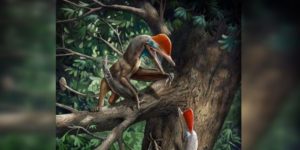Relevance: Prelims: Environment

Context
The new pterosaur fossil was discovered in the Tiaojishan Formation of Liaoning, China, and is believed to be 160 million years old.
Why in news?
Researchers have described a pterosaur species with opposable thumbs, which could likely be the earliest-known instance of the limb.
Important Facts
- The pterosaur species were reptiles, close cousins of dinosaurs and the first animals after insects to evolve powered flight, the American Museum of Natural History says.
- They evolved into various species; while some were as large as an F-16 fighter jet, others were as small as paper airplanes.
- The new pterosaur fossil was discovered in the Tiaojishan Formation of Liaoning, China, and is thought to be 160 million years old.
- It has now been described by an international team of researchers from China, Brazil, UK, Denmark and Japan, and has been named Kunpengopterus antipollicatus, also dubbed “Monkeydactyl”.
What has the team of researchers found?
- “Antipollicatus” in ancient Greek means “opposite thumbs”, and it was attached to the name because the researchers’ findings could be the first discovery of a pterosaur with an opposed thumb.
- “The research team scanned the fossil of K. antipollicatus using micro-computed tomography (micro-CT), a technique making use of X-ray to image an object.
- By studying its forelimb morphology and musculature, they suggest that K. antipollicatus could have used its hand for grasping, which is likely an adaptation for arboreal life,” a press release issued by the University of Birmingham stated.
The recently found pterosaur fossil is far older than the one identified in 2019. Paleontologists had identified that species as a pterosaur that lived over 77 million years ago in what is Western Canada today. Named Cryodrakon boreas, it was believed to be one of the largest flying animals, which “flew over the heads of dinosaurs”, with a wingspan of over 10 metres.
Why is opposability of the thumb important and how did it evolve?
- The Center for Academic Research and Training in Anthropogeny defines opposability of the thumb as being able to “simultaneously flex, abduct and medially rotate the thumb” in a way that one is able to bring the tip of the thumb to touch the tips of the other fingers.
- Along with humans, some ancient monkeys and apes also had opposable thumbs.
- Humans, however, have a relatively longer and distally placed thumb, and larger thumb muscles. This means that humans’ tip-to-tip precision grip when holding smaller objects is superior to non-human primates.
- This is the reason that humans are able to hold a pen, unscrew an earring stopper, or put a thread through a needle hole.
- As per the American Museum of Natural History, the grasping hands of primates developed as a result of their life in the trees — an opposable thumb made it easier for the common ancestor of all primates to cling on to tree branches.

